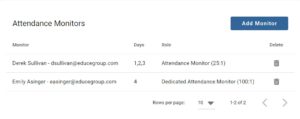In conjunction with the American Institute of Certified Public Accountants (AICPA), the National Association of State Boards of Accountancy (NASBA) has published revisions to the Statement on Standards for Continuing Professional Education (CPE) Programs that became effective on January 1, 2024.
The revisions include significant changes that may impact course development and class management for many accounting firms.
When the revisions were initially approved by NASBA in October 2023, Educe partnered with its Calculo customers to interpret the intentions of the Standards so that system updates to accommodate these changes would support operations in practice. Customers, particularly those in key Big 4 accounting firms, collaborated significantly on these enhancements, providing their input, and thoroughly testing the functionality. This feedback during the testing cycle provided an opportunity to ensure the nuances of the Standard enforcement were considered prior to the initial release of the new product functionality, and its practical use aligned with existing business workflow and content metadata points. As a result, the first round of new functionality has been released and Calculo customers are able to use the technology to enforce the updated Standards.
This post will highlight some of the key changes released to support the new attendance monitoring guidance in S16-05.
NASBA Standard 16-05
When work suddenly became remote due to the COVID pandemic in 2020, many firms had to quickly adapt their Group Live classes to a virtual setting. Since then, classes have continued to be delivered in this manner, instead of redesigning the format to align to the stricter Group Internet-Based Delivery Method requirements. As a result, the new Standard 16-05 describes requirements for sessions developed as Group Live Delivery Method but are delivered virtually. These sessions require that participation be monitored and documented, in addition to requiring a certain number of attendance monitors based on the number of participants. For reference, a copy of the Standard text is included below:
“S16-05 Internet enabled two-way video participation of group live programs. In situations where individual participants log into a group live program and are required to enable two-way video to participate in a virtual face-to-face setting (with cameras on), elements of engagement are required in compliance with S7-01 in order to award CPE credits to the participants. Participation in the two-way video conference must be monitored and documented by the instructor or attendance monitor in order to authenticate attendance for program duration. The participant-to-attendance monitor ratio must not exceed 25:1, unless there is a dedicated attendance monitor in which case the participant-to-attendance monitor ratio must not exceed 100:1.”
Indicator for Virtual Delivery on Group Live Classes
In Calculo, firm-sponsored Group Live classes now have an option to indicate if the class was “delivered virtually via web-enabled two-way video participation.” When this statement is not checked, there is no change to the class requirements and behavior. However, when this statement is checked, the new attendance monitor enforcement functionality is enabled. This statement is displayed in both the Class Admin View and in the Instructor View and will not appear on Group Internet-Based classes or Externally Sponsored Group Live classes.

Attendance Monitors
When a Group Live class is indicated as being “delivered virtually via web-enabled two-way video participation,” then a new Attendance Monitors section displays.

There are two Attendance Monitor roles that can be selected: “Dedicated Attendance Monitor (100:1)” and “Attendance Monitor (25:1).” If Dedicated Attendance Monitor (100:1) is the selected role, users already associated to the class (such as instructors, learners, or other contacts) will not return in the search. Likewise, if a user is a Dedicated Attendance Monitor on a class, then they cannot be added as another role on the class (such as instructors, learners, or other contacts).
Attendance Monitor Enforcement
When a Group Live class is indicated as being “delivered virtually via web-enabled two-way video participation” and the class end date is on or after 1/1/2024, then Calculo will enforce that the required number of attendance monitors need to be present on each class day to calculate and award credit.
When the Dedicated Attendance Monitor (100:1) role is present, then there must be 1 dedicated attendance monitor (per day) per 100 learners. For example:
- 1-100 learners = 1 dedicated attendance monitor
- 101-200 learners = 2 dedicated attendance monitors
- 201-300 learners = 3 dedicated attendance monitors
When the Attendance Monitor (25:1) role is present, then there must be 1 attendance monitor (per day) per 25 learners. For example:
- 1-25 learners = 1 attendance monitor that may also play another role on the class (such as assigned instructor or onsite coordinator)
- 26-50 learners = 2 attendance monitors that may also play another role on the class
- 51-75 learners = 3 attendance monitors that may also play another role on the class
When using a combination of Dedicated Attendance Monitor (100:1) and Attendance Monitor (25:1) roles, then the combination must cover the number of learners. For example, 250 learners could be met by the following sample combinations (not inclusive):
- 1 Attendance Monitor (25:1) and 3 Dedicated Attendance Monitors (100:1) per day
- 2-5 Attendance Monitors (25:1) and 2 Dedicated Attendance Monitors (100:1) per day
- 6-9 Attendance Monitors (25:1) and 1 Dedicated Attendance Monitor (100:1) per day
When the class does not have the required number of attendance monitors associated, then the Approval Checklist shows an error with the number needed to pass validation.

Once the required number has been met, that step passes validation, and the class is eligible to be certified to calculate and award credit.

Virtual Group Live Classes Excluded From Affidavit of Attendance
As Group Live classes that are delivered virtually have specific guidelines around attendance tracking and monitoring, learners are not eligible to submit requests for credit after the fact, similarly to Group Internet-Based classes. The search results in Affidavit of Attendance have been updated to exclude Group Live classes that have the “delivered virtually via web-enabled two-way video participation” statement checked.
Summary
While these are only some of the changes made to incorporate the Standards revisions, the new functionality highlighted above illustrates significant updates to existing forms, validation, and behavior resulting from one paragraph in the Standards. As learning & development and CPE compliance professionals know, any kind of regulatory change can have a substantial impact on both technology and business processes. Additionally, there may not be much lead time to react to such changes. As these new rules are put into practice, Calculo will continue to evolve to ensure that the system supports CPE compliance and streamlined workflows.





